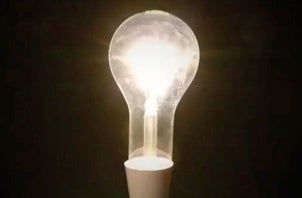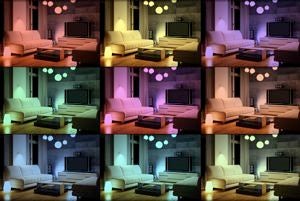
Ever wish you could network all your devices, toaster to television, and manage them on your smartphone? Well, that vision just edged closer with the LIFX LED WiFi enabled smart light bulb.
Using your smartphone or tablet, the LIFX app dims your lights, changes their color, sets them on a timer, or turns them automatically on and off. The bulb even syncs with music to “visualize” your favorite tunes. The potential for late night disco boggles the mind. Not to mention less interesting stuff, like improved energy efficiency.
If it sounds like a good idea to you, you are not alone. The LIFX Kickstarter project opened September 15th with a two-month goal of $100,000. A week later the team exceeded their goal 13 times over and capped pledges at $1.3 million. Up next? Delivering the product by March 2013 as promised.
“We’ve raised more than enough to execute on what we’ve proposed to do so now we are going to get down to the business of creating a full production run of LIFX smartbulbs fit for homes across the world.”
Here’s the LIFX video for your viewing pleasure:
Singularity Hub readers will by now be more than familiar with the Kickstarter funding model and increasing visibility of crowdfunded campaigns—from the Double Fine Adventure video game, to the video consol Ouya, to LiftPort Group’s dream of space elevators. And now joining these funding successes, the LIFX smartbulb.
Perhaps the most appealing aspect of LIFX is the idea’s simplicity.
You need not rewire every light in the house or add dimmer switches. There is no archaic control panel to purchase. Indeed, one merely unscrews that old “dumb” bulb, screws in the new LIFX smartbulb, downloads the app—and Bob’s your uncle.
Each kit has a master bulb and several slave bulbs. The master connects to your local area network (LAN) over WiFi and communicates to the slave bulbs via a mesh network. Though the light switch must remain in the on position as long as you wish to control the system by app, standby energy usage is relatively tiny. According to LIFX, a AA battery would keep the slave bulbs running for one to two years. The master bulb requires roughly two or three watts—but there is only one master needed per set.
Users can control lighting from any WiFi network and turn lights on or off automatically as they come and go. LIFX promises all the standard stuff like timers and dimmers. The bulbs change color and put on a light show to music. Bedroom lights can function as an alarm, gradually brightening to wake you in the morning.
To augment whatever functionality the LIFX team invents, a software developer and hacker kit will loose crowd creativity on their invention. A slew of new apps should make their product more robust.
If you got in on the Kickstarter, LIFX is charging $69 for one smartbulb, $59 for two, and $49 by bulk. Not cheap, to be sure. But if the promised 25-year LED life cycle holds up, your LIFX system would run $2 a year per bulb. And potentially, the LED bulbs could save you some cash on electricity.
Who exactly is in the market for these things? Undoubtedly, some folks who wish to dim their lights without going to the trouble and expense of rewiring an outdated system.

Other people may like the greater efficiency of LEDs (1/10 the energy of standard bulbs) coupled with more efficient lighting control. Forgot to turn off a light? No worries. Go ahead and do it from the office. On a trip? Instead of leaving lights on the entire time, put them on a timer and adjust as necessary on the road.
Still other customers may simply buy LIFX smartbulbs for the novelty. Manipulating mood lighting and throwing impromptu dance parties sounds like fun. But even color control could have a practical application. Going out on a limb here, but nailing the right color could help folks in Portland or Seattle or dreary old London suffering from seasonal affective disorder.
Beyond the specific uses of the technology, LIFX is a cool addition to the internet of things—the idea that increasingly we’ll network all our devices much as we’ve networked people on the internet.
Smart devices will communicate to more efficiently consume energy, follow a schedule, or simply alert us when they need to be serviced or replaced.
Perhaps the greatest part of LIFX is it shows the internet of things may not require any substantial new infrastructure. Many of us already own smartphones and the smartbulbs fit into existing light fixtures. Even better, LIFX isn’t alone in their effort—you can already control your television, thermostat, refrigerator, stereo, and washing machine by smartphone.
Sure some of this stuff is overkill. (Honestly, who needs an LED palm tree shower controlled by their iPhone?) But the larger idea is sound. And ultimately, smartphone controlled smart lighting—indeed smart houses—will put the Jetsons to shame.


